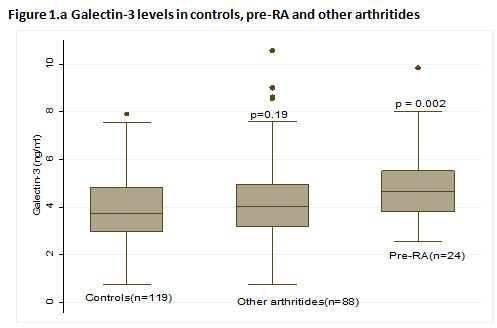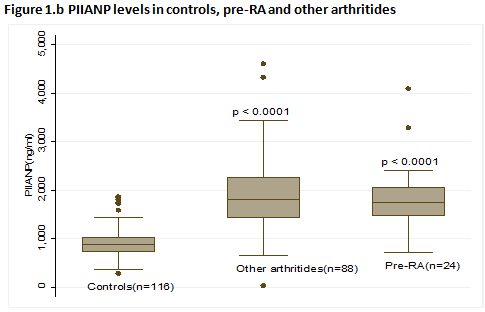Session Information
Date: Monday, November 9, 2015
Title: Imaging of Rheumatic Diseases Poster II: X-ray, MRI, PET and CT
Session Type: ACR Poster Session B
Session Time: 9:00AM-11:00AM
Background/Purpose: Galectin-3 has been
implicated as a mediator of inflammation and erosive progression in animal
arthritis and rheumatoid arthritis(RA). The type IIA procollagen peptide(PIIANP)
is an emerging seromarker for cartilage collagen II synthesis and we have previously reported subnormal
levels in patients with newly diagnosed, untreated RA.
The
aims were to study A. Baseline galectin-3 and PIIANP in patients with
undifferentiated arthritis and to compare the levels in pre-RA and other
arthritides; B. The relationship between galectin-3 and PIIANP with disease
phenotype and MRI findings.
Methods: Patients categorized with early,
undifferentiated arthritis(n=116) were followed up for at least 12 months after
which they were reclassified according to appropriate criteria(TUDAR)(1). Baseline variables included
demographics, biochemical and clinical disease activity measures. Baseline MRI was obtained of
the dominant wrist, MCP, PIP and MTP joints. One hundred and twenty individuals
served as controls. Galectin-3
and PIIANP were measured by ELISA(R&D, Millipore/Linco Research).
Results: Galectin-3 was significantly increased in patients with undifferentiated
arthritis, 4.42 ng/ml (95%
CI 4.08;4.75) vs. controls, 3.96 ng/ml (95% CI 3.70;4.22, p =
0.03), particularly in the
pre-RA subset, 4.99 ng/ml (95% CI 4.30;5.67, p =
0.002). Conversely, galectin-3 in patients with other arthritides than future RA did not
differ from healthy controls (fig 1a). PIIANP was also
increased in the entire group, 1800 ng/ml (IQR 1440;2250) vs.
healthy controls, 888 ng/ml (IQR 742;1029, p < 0.0001). However, when stratifying
according to pre-RA and other kinds of arthritis, PIIANP was equally
increased in these two subsets, 1752 ng/ml (IQR 1483.5;2067, p <
0.0001) and 1801 ng/ml (IQR 1436;2260, p < 0.0001). Galectin-3
and PIIANP did not associate with clinical disease activity measures. However, PIIANP
correlated
negatively with total MRI erosion score in patients with pre-RA, rho=-0.83 p = 0.009.
Conclusion : These
findings indicate that synovitis of any origin elicits a regenerative
chondrogenic response. However,
the
inverse correlation between PIIANP and baseline MRI erosion score
in pre-RA indicates that cartilage collagen II metabolism is skewed
towards a net catabolic state in this arthritis subset. This altered cartilage
metabolic profile may relate to the increased galectin-3 expression in
patients with pre-RA.
1
Duer-Jensen A et al. Arthritis Rheum. 2011;63:2192-202
To cite this abstract in AMA style:
Issa SF, Duer A, Østergaard M, Lindegaard H, Hørslev-Petersen K, Lund Hetland M, Møller JM, Christensen AF, Junker P. MRI Erosions in Undifferentiated Arthritis. Different Associations with the Collagen IIA N-Terminal Propeptide (PIIANP) and Galectin-3 in Pre-RA and Other Arthritides [abstract]. Arthritis Rheumatol. 2015; 67 (suppl 10). https://acrabstracts.org/abstract/mri-erosions-in-undifferentiated-arthritis-different-associations-with-the-collagen-iia-n-terminal-propeptide-piianp-and-galectin-3-in-pre-ra-and-other-arthritides/. Accessed .« Back to 2015 ACR/ARHP Annual Meeting
ACR Meeting Abstracts - https://acrabstracts.org/abstract/mri-erosions-in-undifferentiated-arthritis-different-associations-with-the-collagen-iia-n-terminal-propeptide-piianp-and-galectin-3-in-pre-ra-and-other-arthritides/


